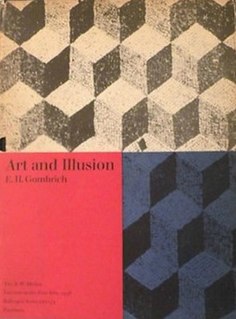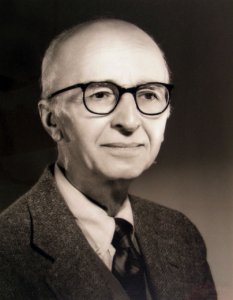Related Research Articles

In the visual arts, style is a "... distinctive manner which permits the grouping of works into related categories" or "... any distinctive, and therefore recognizable, way in which an act is performed or an artifact made or ought to be performed and made". It refers to the visual appearance of a work of art that relates it to other works by the same artist or one from the same period, training, location, "school", art movement or archaeological culture: "The notion of style has long been the art historian's principal mode of classifying works of art. By style he selects and shapes the history of art".

Sir Ernst Hans Josef Gombrich was an Austrian-born art historian who, after settling in England in 1936, became a naturalised British citizen in 1947 and spent most of his working life in the United Kingdom.

The Warburg Institute is a research institution associated with the University of London in central London, England. A member of the School of Advanced Study, its focus is the study of cultural history and the role of images in culture – cross-disciplinary and global. It is concerned with the histories of art and science, and their relationship with superstition, magic, and popular beliefs.

The Story of Art, by E. H. Gombrich, is a survey of the history of art from ancient times to the modern era.
Michael David Kighley Baxandall, FBA was a British art historian and a professor emeritus of Art History at the University of California, Berkeley. He taught at the Warburg Institute, University of London, and worked as a curator at the Victoria and Albert Museum. His book Painting and Experience in Fifteenth-Century Italy was profoundly influential in the social history of art, and is (2018) widely used as a textbook in college courses.
Michael William Lely Kitson was a British art historian who became an international authority on the work of the painter Claude Lorrain.
William J. R. Curtis is an architectural historian whose writings have focused on twentieth century architecture. Curtis seems particularly interested in broadening the "canon" to include a wider range of architects working across the world.

Art and Illusion, A Study in the Psychology of Pictorial Representation, is a 1960 book of art theory and history by Ernst Gombrich, derived from the 1956 A. W. Mellon Lectures in the Fine Arts. The book had a wide impact in art history, but also in history, aesthetics, semiotics, and music psychology.
Neuroarthistory is a term coined by Professor John Onians, an art historian at the University of East Anglia in 2005. Neuroarthistory is an approach that concerns the neurological study of artists, both living and dead.
Svetlana Leontief Alpers is an American art historian, also a professor, writer and critic. Her specialty is Dutch Golden Age painting, a field she revolutionized with her 1984 book The Art of Describing. She has also written on Tiepolo, Rubens, Bruegel, and Velázquez, among others.
World art studies is an expression used to define studies in the discipline of art history, which focus on the history of visual arts worldwide, its methodology, concepts and approach. The expression is also used within the academic curricula as title for specific art history courses and schools.
Mark Louis Hallett is an English art historian specialising in the history of British art. He is currently Director of Studies at the Paul Mellon Centre for Studies in British Art.
Peter Erik Lasko was a British art historian, Professor of Visual Art at the University of East Anglia, from 1965 to 1974, Director of the Courtauld Institute of Art, London, from 1974–85 and a Fellow of the British Academy.

An architectural style is a set of characteristics and features that make a building or other structure notable or historically identifiable. It is a sub-class of style in the visual arts generally, and most styles in architecture relate closely to a wider contemporary artistic style. A style may include such elements as form, method of construction, building materials, and regional character. Most architecture can be classified within a chronology of styles which changes over time reflecting changing fashions, beliefs and religions, or the emergence of new ideas, technology, or materials which make new styles possible.
Kerry John Downes was an English architectural historian whose speciality was English Baroque architecture. He was Professor of History of Art, University of Reading, 1978–91, then Emeritus.

Michael J. Rosenthal is emeritus professor of the history of art at the University of Warwick. He is a specialist both in British art and culture of the eighteenth and early nineteenth centuries, and the arts of early colonial Australia.

Jean Victor Edmond Paul Marie Bony was a French medieval architectural historian specialising in Gothic architecture. He was Slade Professor of Fine Art at the University of Cambridge from 1958 to 1961, Fellow of St John's College, Cambridge, and Professor of Art at the University of California at Berkeley, from 1962 to 1980.
David Edward Hemsoll FSA is a British art and architectural historian, specialising in Renaissance art and architecture, especially that of Rome, Florence, and Venice. He has published numerous catalogue essays and books that address architectural theory and the methodology of architectural design. He is currently (2020) Senior Lecturer in the Department of Art History, Curating and Visual Studies at the University of Birmingham.
Andrew Henry Robert Martindale (1932–1995) was Professor of Visual Art at the University of East Anglia at the time of his sudden death, aged just 62. One of the pioneers in the teaching of art history as an academic discipline and a founding member of the Association of Art Historians, he was also a highly respected medieval scholar specialising in the late gothic and early renaissance periods with a number of publications to his name. His 1972 book, The Rise of the Artist, is much vaunted, often cited, and has been described as ‘a brilliant study of the hierarchies within the medieval patronage system’.
Julian Richard Gardner is a British art historian and Professor Emeritus at the University of Warwick. A scholar of late medieval and renaissance Italian art, particularly patronage, and a Giotto di Bondone specialist whose expertise has led to a number of scholarships and appointments as visiting professor at various institutions both in Europe and America.
References
- ↑ "Dr John Onians". Society of Antiquaries of London. Retrieved 8 January 2022.
- ↑ "john onians". johnonians.academia.edu. Retrieved 8 January 2022.
- 1 2 "John Onians: CV". Global Art Museum. Archived from the original on 26 July 2011.
- 1 2 "John Onians | International Meeting on Contemporary Architecture in Historic Cities". unesco.urbanismosevilla.org. Retrieved 8 January 2022.
- ↑ Carey, Brainard (29 July 2016). "John Onians". Interviews from Yale University Radio WYBCX. Retrieved 8 January 2022.
- ↑ Onians, J. (1979) Art and Thought in the Hellenistic Age: Greek World View, 350-5 B.C. (Paperback) Thames & Hudson Ltd
- ↑ Onians, J. (1989) Bearers of Meaning: Classical orders in Antiquity, the Middle Ages and the Renaissance Princeton University Press; New Ed edition (1 July 1992)
- ↑ Onians, J. (1999) Classical Art and the Cultures of Greece and Rome Yale University Press
- ↑ Onians, J. (2008) Neuroarthistory: From Aristotle and Pliny to Baxandall and Zeki Yale University Press
- ↑ Onians, J (2016). European Art: A Neuroarthistory. Yale University Press. ISBN 978-0300212792.
- ↑ Onians, J. (Ed.) (1994) Sight and Insight: Essays on Art and Culture in Honour of E.H.Gombrich at 85 Phaidon Press Ltd
- ↑ Onians, J. (Ed.) (2004) Atlas of World Art Laurence King Publishing
- ↑ Onians, J. (Ed.) (2006) Compression Vs. Expression: Containing and Explaining the World's Art (Clark Studies in the Visual Arts) Yale University Press
- ↑ Fernie, E. (1995) Art History and its Methods: A Critical Anthology Phaidon
- ↑ Golden, L. (Ed.) (2002) Raising the Eyebrow: John Onians and World Art Studies
- ↑ "Who made the Conway Library?". Digital Media. 30 June 2020. Retrieved 8 January 2022.